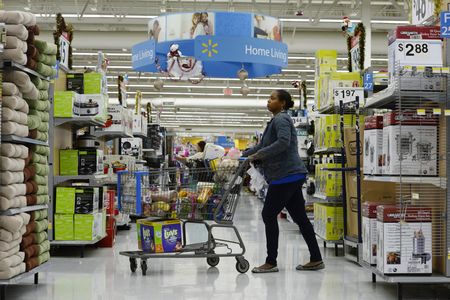
By Lucia Mutikani
WASHINGTON (Reuters) – U.S. consumer spending stagnated in May as households cut back on purchases of motor vehicles and other long-lasting goods amid higher borrowing costs, suggesting a considerable loss of momentum in economic growth in the second quarter.
While the Commerce Department’s report on Friday showed annual inflation rising last month at its slowest pace in two years, underlying price pressures remained too strong to discourage the Federal Reserve from returning to its strategy of raising interest rates in July, economists said.
The soft consumer spending offset a raft of upbeat data this month, which had painted a picture of a resilient economy.
“The recent stalling of consumer spending and somewhat better inflation news validate the Fed’s decision to skip a meeting this month, though continued stickiness in core prices likely warrant another tap on the brakes in July,” said Sal Guatieri, a senior economist at BMO Capital Markets in Toronto.
Consumer spending edged up 0.1% last month. Data for April was revised lower to show spending accelerating 0.6% instead of 0.8% as previously reported. Economists polled by Reuters had forecast consumer spending, which accounts for more than two-thirds of U.S. economic activity, rising 0.2%.
Spending on goods dropped 0.5%, with motor vehicle outlays plunging 23.3%. Spending on gasoline and other energy goods tumbled 23.4%, largely reflecting lower prices at the pump.
Outlays on services increased 0.4%, lifted by healthcare, transportation, housing and utilities, as well as financial services and insurance. Services outlays rose 0.5% in April.
When adjusted for inflation, consumer spending was unchanged after increasing 0.2% in April. The stagnation in so-called real consumer spending last month implied that consumer spending moderated sharply in the second quarter after rising at its fastest pace in nearly two years in the January-March period.
Strong consumer spending accounted for the economy’s 2.0% annualized growth pace last quarter, defying fears of a recession because of the Fed’s hefty rate hikes.
Nevertheless, the economy likely continued to chug along in the second quarter, with job growth, housing starts, orders for long-lasting manufactured goods all strong and the goods trade deficit narrowing in May.
Consumer spending remains underpinned by strong wage gains in a tight labor market. Personal income rose 0.4% last month, with wages increasing 0.5%. Slowing inflation is raising consumers’ purchasing power. The saving rate climbed to 4.6% from 4.3% in April.
But the outlook is less favorable.
Most lower-income households are believed to have depleted savings accumulated during the COVID-19 pandemic.
About 26.6 million Americans with federal student loans will start making interest payments in October when a more than three-year moratorium ends. Morgan Stanley estimates that the hit to households’ disposable income could lower inflation-adjusted consumer spending by about 10 basis points this year and slice 7 basis points off GDP growth.
The personal consumption expenditures (PCE) price index gained 0.1% in May after rising 0.4% in April. In the 12 months through May, the PCE price index advanced 3.8%. That was the smallest year-on-year increase since April 2021 and followed a 4.3% rise in April.
Excluding the volatile food and energy components, the PCE price index gained 0.3% after rising 0.4% in the prior month. The so-called core PCE price index increased 4.6% on a year-on-year basis in May after advancing 4.7% in April. The Fed tracks the PCE price indexes for its 2% inflation target.
(Reporting by Lucia Mutikani; Editing by Jonathan Oatis)
